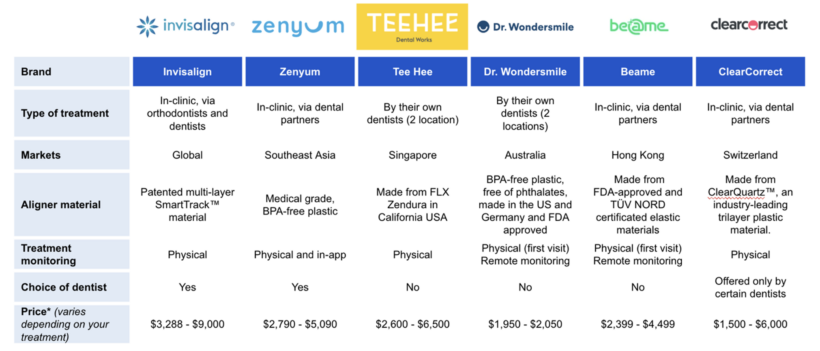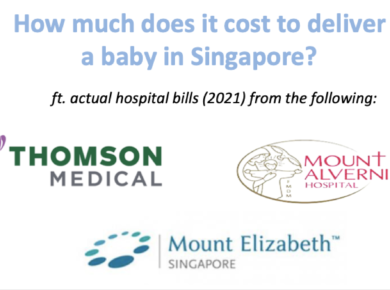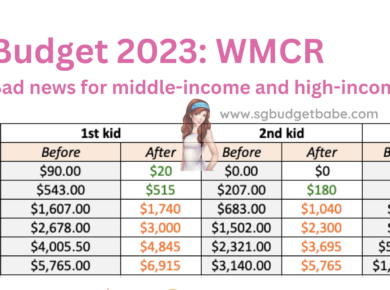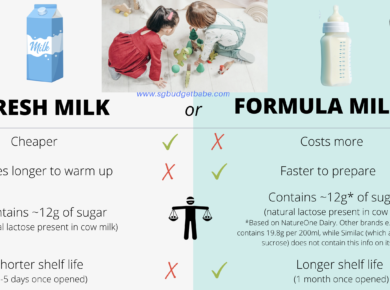Growing up, I was bullied for my looks and over my “bugs bunny” teeth. Getting metal braces changed my life – but before that, I had to put up with another 2 years of taunting first. Let’s face it: not everyone in high school is kind towards those who aren’t blessed with good looks (or genes).
For many, the only way to attain a great smile is to opt for orthodontic treatments to correct misaligned teeth and bite issues. However, as teeth straightening treatments are generally considered cosmetic, they are hardly eligible for subsidies or insurance claims.
So as a consumer who needs to get their teeth corrected and have to pay for it yourself, what treatment should you go for?
My teeth correction experience
During my time, the only option was to use wire braces to correct my teeth. But while they did the job, one after-effect that no one really talks much about is how we have to be diligent about wearing our retainers for the years after to prevent relapse. While I kept up with wearing my retainers every night for about 10 years, I fell behind after I got pregnant and life got more hectic as I had to care for my two young kids, often at the expense of my own self-care.
As a result, the gaps in my teeth have returned, and I’ve been toying with the idea of correcting them again, especially since food tends to get stuck in between them often.
In recent years, thanks to the advancements in science and technology today, clear aligners are now a thing. Your friends probably wouldn’t even notice that you have them on, and you wouldn’t have to put up with insults like “metal mouth” in school or at the workplace like I had to.
And whereas they used to be a luxury that only the richer families could afford to pay for, today, many of the original patents have since expired and the cost of clear aligners have come down significantly.
Many of my friends who have older kids are now opting for these solutions – with the 2 most prominent brands in Singapore being Invisilign or Zenyum.
But is there an advantage that wire braces have above clear aligners, and how does one go about choosing between the different aligner brands?
To answer that question, I started my research and spoke with different experts to find out.
Wire Braces vs Clear Aligners
Wire braces vs. clear aligners – which option is more suitable for you?
Since the 1800s, the de facto course of treatment used by dentists to correct teeth involved wire braces – i.e. metal brackets that attach to your teeth and connected by wires and sometimes elastic bands. These are generally worn for anywhere between 12 to 24 months, depending on the extent of correction needed for each individuals’ teeth condition and the movement progress of the teeth.
The history of clear aligners, on the other hand, is much shorter. In 1997, two Stanford University students, Zia Chishti and Kelsey Worth, invented the world’s first complete clear aligner system. Similar to a clear mouthguard, this involves using a clear plastic tray that is shaped to fit over your teeth that applies pressure on specific areas to push your teeth into proper alignment. It is usually worn for a minimum of 22 hours a day, for 12 to 18 months. Known as Invisalign, the concept involved a series of removable clear plastic aligners aimed at adults seeking discreet orthodontic treatment. They combined aligner therapy with 3D imaging technology, which also removed the tedious process of manual fabrication.
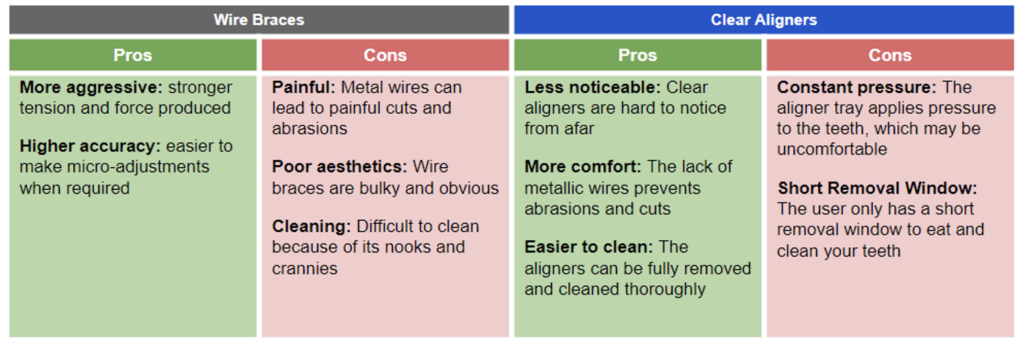
While clear aligners definitely sound more appealing, metal braces might still be more suitable for some people and in certain cases:
- If you’re forgetful or lack the discipline to wear your clear aligners for prolonged hours, then metal braces could be better since it is semi-permanently stuck on your teeth.
- During each dental review, your dentist has the leeway to immediately tweak the strength (pressure) and direction of the wires on the spot, so as to ensure that your teeth move in the desired direction. This is in contrast to having to potentially adjust and wait for a new set of invisible aligners to be produced and shipped to you later.
- In terms of cost, prolonged treatment on wired braces will be cheaper as compared to having to order more clear aligner sets.
Once you’ve completed your orthodontic treatment, retainers are usually worn for at least a year to the rest of your life to prevent relapse – especially since teeth shift naturally due to everyday habits like chewing or grinding.
Whichever your preference is, you will need to consult a dentist in Singapore, who will then assess whether your case is more suitable for metal braces or clear aligners.
How to choose between clear aligner brands in Singapore
I compiled the below table while doing my research, and my first thought was, why are there so many brands to choose from?! And how on earth will a consumer know what to choose?
We have 2017 to thank, as that was a landmark year for the industry with the expiry of Invisalign’s patents on their clear aligners. This opened up the gates for more competitors to mimic and come up with their own inspired versions, with each competing on price in order to try and take away market share.
Normally, when patents expire, consumers can benefit from lower prices and generic brands (think of Panadol vs. paracetamol). However, when it comes to orthodontic treatments, cost is not the only factor.
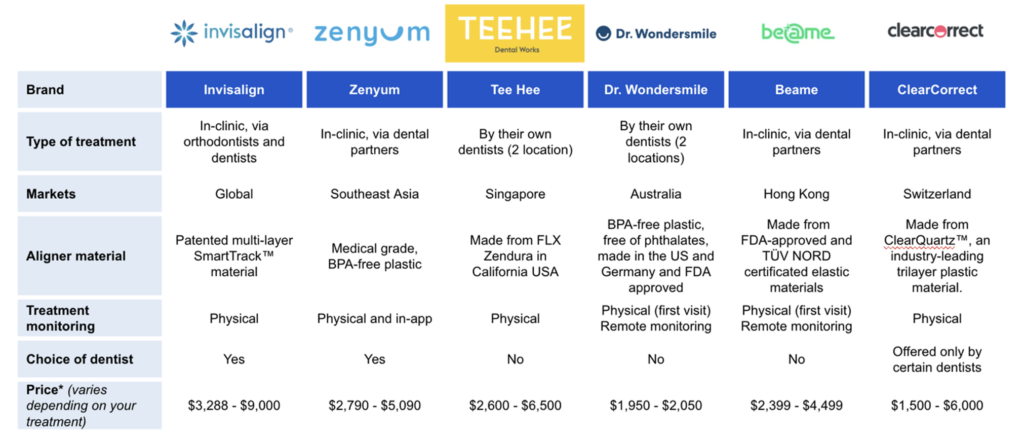
Here are a few questions to consider and help you decide.
1. How much in-person dentist supervision do you need?
Since correcting teeth involves moving of actual bones, do you prefer having a dentist assessing and monitoring their condition in-person and make adjustments as necessary, or are you comfortable to be monitored remotely for follow-ups?
I found that some brands – e.g. Dr. WonderSmile and Beame – claim that you will barely need to visit a dentist clinic after the initial trip. I don’t know about you, but that essentially eliminates them from my list.
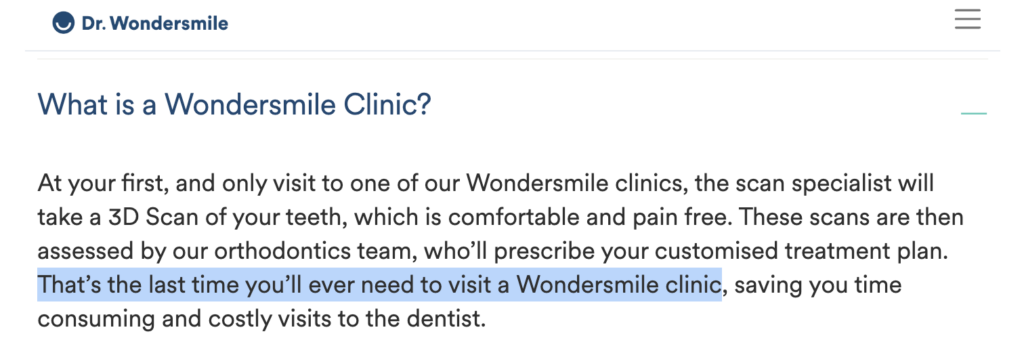

I interviewed a consumer, Ke Hui, who started using clear aligners in 2022 and whose treatment got prolonged:
“I did do quite a lot of research before deciding on using Invisalign, but mainly it was because of how reputable it was. I heard many horror stories from my friends about other clear aligner brands where no dentist was involved in the process, and it ruined the nerves found in their gums and became a health issue.”
While she was told that her treatment would only last 2 years, it got extended to 3. This was mainly due to a specific tooth which her dentist had highlighted as a ‘tough movement tooth’ from the start.
“Using the Invisalign system was really comfortable and I didn’t experience any ulcers from it. The great thing (as compared to traditional braces) is that I could remove it whenever I needed, and it helped that there is an actual dentist that I visit every 3 weeks to get updates on my treatment.”
Overall, despite the prolonged treatment, she still felt it was $5,000 well spent to ensure her teeth were straightened properly and safely.
2. Does the brand’s history matter to you?
Given that aligner technology is still relatively new to most, if you care about how many patients have been treated successfully before you, then you should remember that these newer brands naturally have fewer case studies, given their shorter history.
When it comes to having the most number of successful – and most complex – cases as proof that a brand’s clear aligners work, there’s no doubt that the crown goes to Invisalign as they were the pioneers.
3. How much of your treatment can really be done remotely?
Some brands have gone direct-to-consumer, adopting a B2C model that reduces the fee of the middlemen (i.e. the dentist, with brands getting overseas dentists to look at photos to prescribe the treatment). Become was such a brand, previously available to Singaporeans who travelled up to Johor Bahru and Kuala Lumpur. In a 2020 interview with the Vulcan Post, their co-founder Vivien Bresson talked about being able to offer (70%) lower prices as they cut out the dentists/orthodontists, stating that they “digitalise[d] the process through the impression kit or 3D scan booking, the treatments and the remote monitoring follow-ups”. They have since gone silent since 2021, with some sources suggesting that this was due to their business model being ordered to shut down by the authorities. Unfortunately, I wasn’t able to find any online news or articles on this topic to verify the rumours, but it is indeed odd that they seem to have disappeared without a word.
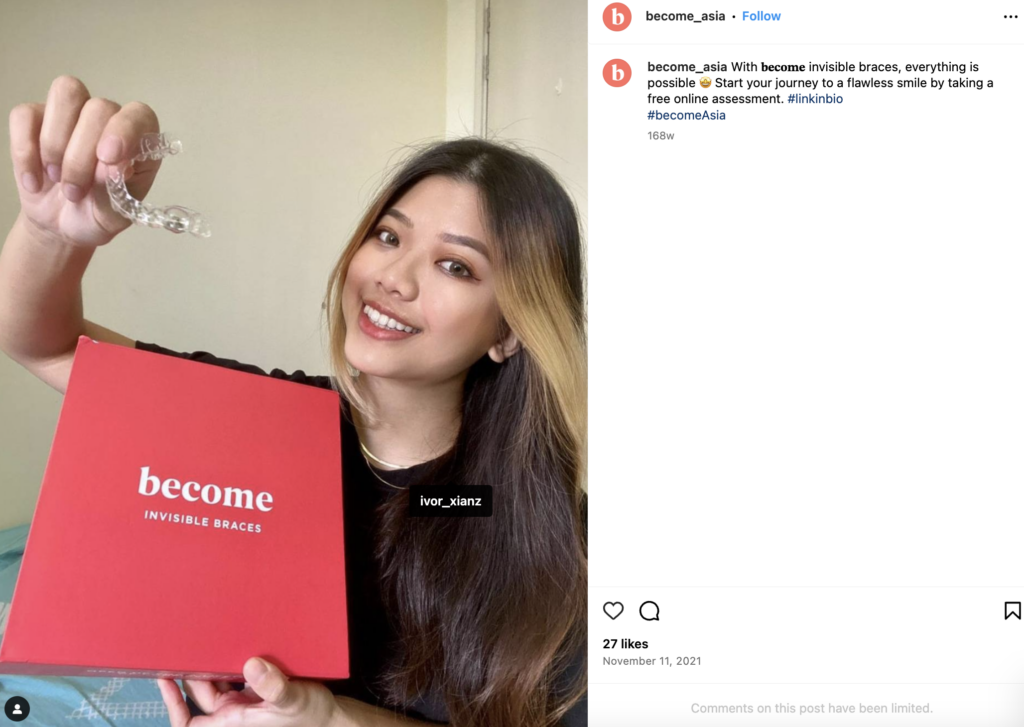
In some questionable cases, some brands even eliminated the medical practitioner entirely; this is not allowed in Singapore, so be careful if you see any of these being marketed to you online!
I spoke with Kylie, who was attracted by the low cost and ease of one such brand, but ended up throwing the entire set away:
“I found that brand online and it was half the price (of Invisilign), but it didnt close my teeth gaps at all so I stopped halfway and switched after finally visiting my dentist.
My dentist recommended that I do Invisilign and my progress ended up even faster than we both expected, so I managed to get my straight teeth in time for my wedding! During our regular reviews, my dentist could even help shave off to manually smoothen the aligner edges for a more comfortable fit for me. If you’re not seeing your dentist in-person, this would be impossible to do it yourself.
I regret using a B2C brand instead of going straight to Invisilign right from the start. Please learn from my mistake and do not just go for the cheapest cost, it is not worth it because you really don’t want to screw up your teeth.”
Case Study: The collapse of Smile Direct Club
Become was not the only one. Shortly after Invisalign’s patents expired, Smile Direct Club gained popularity as a brand that initially promised to disrupt traditional dentistry with lower cost, remotely- supervised care. They even IPO-ed successfully in 2019.
However, various orthodontists – and even famed investment firms like Hindenburg Research – had voiced their alarms, warning that it would “wind up as a case study in why it’s a bad idea to invest in a company that attempts to fit a complex, dangerous medical process onto a low-cost, high volume assembly line”.
In 2020, a dentist posted his comments publicly on Quora comparing Invisalign vs. this (cheaper) competitor. Shortly after, in December 2023, SmileDirectClub wound up their operations, leaving thousands of customers in limbo; the brand’s “Lifetime Smile Guarantee” no longer meant anything as the company ceased to exist. Customers had to seek out alternative aligners and retainers from other brands as a recourse, at their own expense.
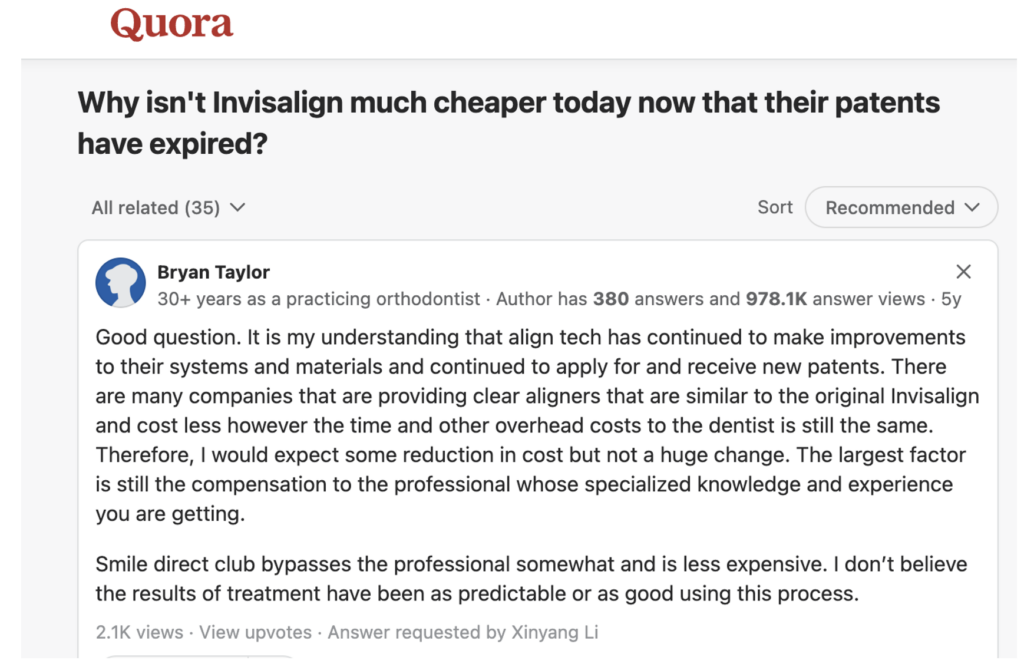
When things started going awry, Smile Direct Club even forced its unhappy customers to sign non-disclosure agreements if they wanted to get a refund…until a government lawsuit forced it to end the practice in 2023 and shut down its global operations.
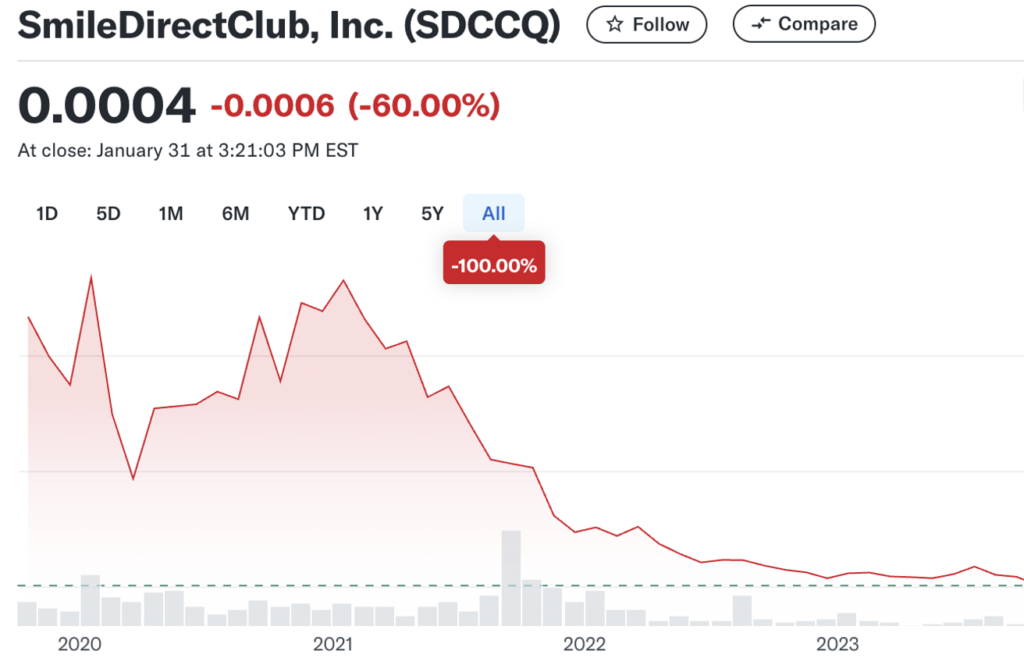
The failure of Smile Direct Club made consumers all over the world rethink whether orthodontic treatment could truly be handled remotely, and the cases that went wrong highlighted the perils of doing so.
4. Can you risk or afford for your treatment to go badly?
Before you think about simply going for the cheapest option, it is worth remembering that orthodontic treatment is ultimately considered a medical procedure and a doctor-led therapy, which requires the guidance of a professionally-trained dentist or orthodontist to provide individualized treatment to the patient.
In worst case scenarios, you might end up with bite issues, permanent nerve damage or even tooth loss.
These were some of the issues reported by Smile Direct Club’s customers abroad, and the dentists who worked on these customers after had pointed out that:
- 3D scans alone are insufficient to diagnose and prescribe a treatment; any decent dentist will definitely do at least an X-ray to find hidden teeth that the patient may not know about.
- If decay or gum disease is missed in a physical check-up, people risk losing some of their teeth. It is hard to spot these from just submitted photos alone.
- Should the roots of a patient’s teeth be too short to withstand the pressure from aligners, these can be picked up from an X-ray, but certainly not from tele-consults nor sending pictures of your teeth over an app to a remote dentist.
As much as I’d love to save on costs, my research helped me to conclude that too much is at stake here when it comes to moving bones. I will now only dare to go for a brand supported by a specialist dentist, rather than one that purports to help me get a perfect smile in a presumably short period of time at a lower price.
5. Choosing between Invisalign and Zenyum?
The most familiar brands in Singapore right now are Invisalign and Zenyum, and for many customers, the decision may very well come down to between these two.
I read through numerous consumer reviews on forums like HardwareZone, Reddit and Quora, and found several commonalities:
- Comfort – many people shared that Invisalign was more comfortable.
- Frequency of visits – every 6 – 8 weeks with your dentist on Invisalign, but usually 2 – 3 times with Zenyum as the rest of the consultation will be mostly done via their app.
Disclosure: For the purpose of my research, I reached out to both Invisalign and Zenyum (which I’ve also narrowed down my choices to) in order to get their side of the story.
Being the first-mover, Invisalign obviously has the highest number of patients treated and success case studies. For anyone who cares about medical patents, clinical studies and an extensive history of success, then Invisalign would probably appeal to you.
I also emailed Invisalign’s Singapore team to ask how they were superior than their competitors, and this was their response:
“The Invisalign treatment system is the most advanced clear aligner system in the world and is backed by more than two decades of innovation. Our unique proprietary technology (SmartForce, SmartStage) and proprietary material (SmartTrack) makes it the leading clear aligner system.
260 materials were tested to come up with SmartTrack material which is comfortable, has high elasticity and high durability providing constant gentle force to move the teeth incrementally with every aligner change.
Our proprietary multi-layer SmartTrack material is clinically proven to improve tooth movement. Invisalign G8 is the only clear aligner system with the advantage of SmartForce aligner activation, where select areas on the aligner surfaces are specifically contoured to apply forces to the tooth surface in the proper direction to produce the desired movement and minimize unwanted movements.“
In terms of what makes them unique, they pointed out that Invisalign aligners and retainers are trimmed based on each patient’s gum line to provide optimal patient comfort and aesthetics. This aligned with what Kylie told me in her interview as well.
In terms of cost, my own dentist quoted me $3,500 for my treatment on Invisalign, although my online research and interviews with other patients found cost ranges of up to $7,000 – $9,000 as well.
But if you’re cash-strapped and can only afford cheaper options, then brands like Zenyum might be more appealing to you given their current pricing:
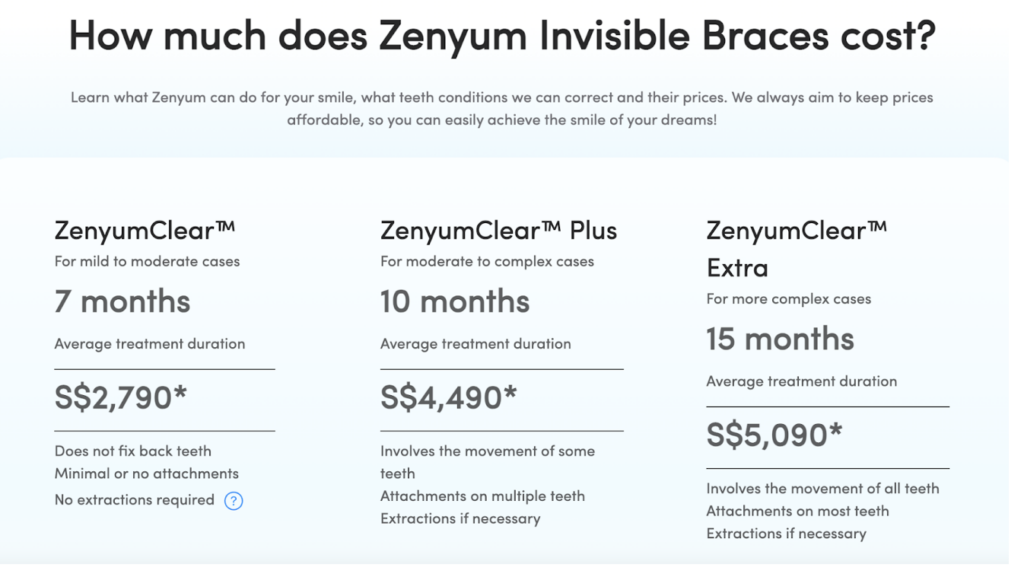
While you as an individual can express a preference for certain brands, but ultimately, it has to be a partnership with your dentist to decide together on what’s best for your situation.
After all, I’ve heard of cases of patients who wanted the Zenyum system, but their dentist did not offer it initially. Hence, they worked together to bring Zenyum onboard for the dental clinic, and the rest is history.
6. Does the quality of the aligner material matter?
While the physical look of the clear aligners offered by the different brands may look similar, several experts have pointed out to me that it isn’t the same.
According to Dr Kelvin Chua, the clinical director of Gentle Smile Dental Studio and an Align Faculty member, the materials used in the clear aligner is important.
“Material does play a part. (It affects) how much force is applied on the teeth and how well the strength remains after wearing for more than a week in the mouth. Other than material quality of the clear aligners, the design of the attachment and the experience of the dentists matter. With the right attachment and right planning from the dentists, it can also produce different results.”
I decided to seek out a second opinion and interviewed Dr Sandy Ng, a dentist with Q&M Dental Group, as I asked her how she decides on which brands to recommend to her patients:
“Usually for extraction cases, fixed braces may be more predictable. Or I might recommend it for my patients who are not confident to wear their aligners for at least 20 hours per day.
When it comes to clear aligners, Invisalign SmartTrack is the fastest I’ve seen on the market to correct teeth misalignment. They have spent a decade doing R&D for this while most aligner brands have done mostly copying and minimal R&D. Most are not able to replicate SmartTrack technology as of yet, which is why their aligners take at least twice as long to achieve the same movements, from what I’ve seen in clinical cases and online.”
She also cautioned me against simply going for the cheapest brand, and said:
“You should also consider how long your treatment will take, and how complex it is, as a cheaper option may add up to a more expensive one in the end should you end up having to pay for additional aligners again and again because your condition has still yet to be corrected.”
Nonetheless, I’ve a few friends who used Zenyum (note: they were sponsored as influencers), so I reached out to Zenyum representatives to ask about their material and check if these claims about material superiority were true.
This was their response to me:
“Our invisible braces are made of medical-grade, BPA- free and latex-free plastic.
Innovation in material for Clear Aligners has been driven for the past +25 years and most patents in the space have expired. This allows providers of Clear Aligners to compete with each other on equal footing and marginalize the differences between the materials: the input in terms of a treatment plan and knowledge on how to move teeth is probably a bigger factor in creating great outcomes than the material itself.
We launched Zenyum in 2018 in Singapore, with the view to bring innovation to the Clear Aligner space, by being more efficient in the way we do things, without compromising clinical safety or product quality. We use technology to assist the local dentists in their monitoring of patients and accordingly save time.
After six years of innovation and treating over 50,000 customers, we believe that our products, outcomes and capabilities compete with the best systems out there.”
I dug a little deeper online myself, and found that Zenyum has an ISO 13845:2016 certified by British Standards Institution (BSI).
ISO 13485 is the internationally recognized standard for quality management systems in the design and manufacture of medical devices. It outlines specific requirements that help organizations ensure their medical devices meet both customer and regulatory demands for safety and efficacy.
On the other hand, Invisalign has a 510K regulatory clearance – by the US Food and Drug Administration (FDA). Some consumers may appreciate this more, since it is one that is far harder to obtain than an ISO. So if that sort of certifications matter to you, then you may want to do your own research first on what your brand has obtained, before you decide.
7. Could a cheaper option end up in you having to do it twice?
With so many brands in the market offering clear aligners, I too, was tempted to just go for the most affordable one. However, I soon realised that may not be the wisest course of action after understanding how several users have shared that they needed to have another round of clear aligners done because their initial treatment (with cheaper brands) did not work. Kylie was not the only one, but unfortunately, a few other influencers I found with similar sentiments declined to be interviewed or named in this piece.
A friend of mine who works in marketing for a dental clinic also shared with me that she has been approached by a few influencers who previously used another brand, but are now seeking a remedy to their bite issues which were not corrected despite compliance and completing the program. Online, there are similar reviews you can find from customers who have gone down the cheaper route as well.

A quick search will pull up reviews found on forums like Reddit about brands offering cheaper clear aligners such as Dr. Wondersmile and Zenyum. While they may seem like the affordable option (with prices starting from $2k++), there have been consumer feedback about some having to go through multiple revisions as the initial alignment was not done well.
Another consumer, Ms Evonne Ng, shared her feedback with me after having used metal braces, Invisalign and is now on Clear Correct:
“I have been with my dentist for a really long time, and I’ve seen how one’s dental health, bite and daily habits needs to considered before a dentist can come up with a treatment plan. Having an experienced dentist who understands your condition is better than being assigned or given the choice of dentists you are not familiar with, or dealing with tele-consults instead of physical visits.
While Zenyum is no doubt cheaper and provides a treatment plan signed off by one of their partner dentists, I wasn’t comfortable because my own doctor knows better about my bite, dental history and sleeping habits where I breathe through my mouth, and factored these into my treatment plan. He is knowledgeable and well respected in his field – so he must have done his own comparisons among the many aligner brands. Therefore, I’d take his advice with whichever brand he feels would work best for my case.
I’ve heard reviews from my friends who tried Zenyum, and they say the bite doesn’t always align. When it comes to one’s teeth, I would suggest to not to take any chances just because the price is cheaper.”
Consumers will do well to remember that the cheaper brands often come with fewer dentist visits, since a portion of the fees that would otherwise be payable to the dentist has been eliminated from the treatment process and is being remotely in-app through your photo submissions instead.
Whether you’re comfortable with doing some of your adjustments online rather than in the clinic…that is a personal decision you have to make.
Any (cheaper) brand that allows you to simply do a “smile assessment” and take a 3D scan of your mouth before you start your treatment, is one that you might want to be cautious of. Since correcting teeth can lead to lifelong outcomes, you might want to work with an actual dentist who has seen your teeth in-person to understand their professional advice on what your treatment options should be.
Conclusion
While aligner options are aplenty, at the end of the day, your priority should first to get your teeth assessed by a professional and then listening to their prescribed treatment plan for you.
If you have a preference towards a certain aligner brand, it is worth discussing this with your dentist to understand why it may (or may not) be suitable in your case. They might be able to share more insights that you weren’t previously aware of.
While brands like Zenyum, TeeHee and Dr. Wondersmile offer free online suitability tests – note that you will ultimately still need to visit a dentist first who can properly diagnose your condition for you before you start on any treatment, since this is a rule by MOH for all clear aligner brands offered in Singapore.
At the end of the day, these are my own takeaways from my research and interviews:
- Make sure your treatment is being prescribed by a licensed dentist in Singapore who has reviewed your case in person. If in doubt, ask the clear aligner provider this question: “Who is the dentist signing off and monitoring my treatment outcomes – is this person based overseas?”
- Think about if you want to choose your dentist and then work with their recommended brand, or choose your brand and then have the dentist assigned to you.
- Do note though that some dentists only work with their preferred brands as well, so you may or may not be able to get them to treat you using a brand that you want.
- Each brand will naturally say they are the best. However, “best” is subjective and you will have to ultimately decide what factors mean more to you, such as between price, scientifically-backed studies or medical citations, certifications, history (number of years in operation), number of patients treated, etc.
Most of the dentists I spoke to concurred that a human dentist is still integral to the entire treatment, and will be the biggest pivotal decision in determining the success of your braces / aligner journey. It is not advisable to embark on your treatment plan through virtual consultations rather than in-person visits. And per Kylie’s experience, do not attempt to correct your own teeth by yourself as it is not as simple as just purchasing clear aligner trays online and wearing them.
And while many marketing tactics by such companies involve shorter durations (as short as 6 months, vs the conventional 1 to 2 years), you should not take that number at face value, or you’ll only end up disappointed when your treatment gets prolonged or you end up having to pay more.
Thoroughly understanding your orthodontic severity allows you to make an informed decision. Price shouldn’t be your only factor in making a choice. You should also consider how long your treatment will take, how complex it is, how often you’ll be getting follow-up assistance on, and how comfortable you are with your dentist’s clinical acumen to help you achieve the most optimal outcome in the shortest period of time.
And finally, don’t make the mistake of simply going for the cheapest – a cheaper option may just add up to a more expensive one in the end when you have to pay for realignment again and again for the perfect smile.
Disclaimer: This is a journalistic piece on the industry and market offerings; it should not be taken as medical advice. Extensive attempts have been made to deep dive into this topic and present a balanced view by featuring perspectives gleaned from dentists, consumers and several aligner brands. This piece has been vetted by licensed dentists practicing in Singapore (those whose quotes were featured), but has not been vetted prior to publication by any local regulators or medical board. Should you spot any factual inaccuracies in the article, please leave a comment below to help inform fellow readers and for me to make considerations for any amendments necessary.
